Section 1 Subsystems
Memory -
Memory performance is very important on a motherboard, especially when you have a CPU with multiple cores and threads. If you have slow memory your cores and threads can become starved for data to execute. To test memory performance we run both Sisoft’s SANDRA and AIDA64. These two combine to not only give us accurate numbers but to validate each other. For testing at stock speeds the memory is hard set to 16000MHz while overclocking testing is done at the highest stable speed for the voltage of 1.55v this is due to the different memory dividers for each CPU. As such, the memory speeds will vary greatly. This means that the overclocked numbers are a little misleading and while they can show a trend are really only included to show if a board has a problem with memory performance at high clockspeeds.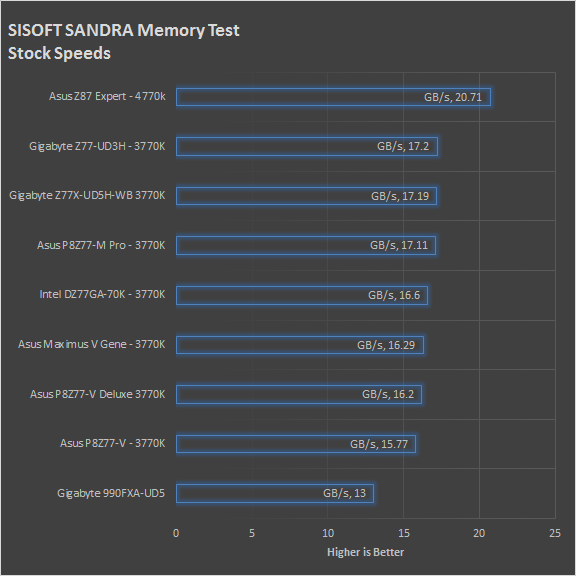
Haswell brings a nice bump to native 1600MHz memory speeds. This does not mean that your memory will automatically run at 1600MHz, right now most RAM will still be set to 1333MHz stock. To get to 1600MHz you will need to manually set it through the BIOS. Once you do this though you can see the performance increase you get from running the memory at this speed. Haswell plus the Z87 Chipset gives us a healthy jump in memory performance over Sandy and Ivy Bridge. This extra memory headroom can help make the system much more efficient for multi-media, gaming, and well almost everything. It can also mean less disk access with in turn can mean a slight power saving.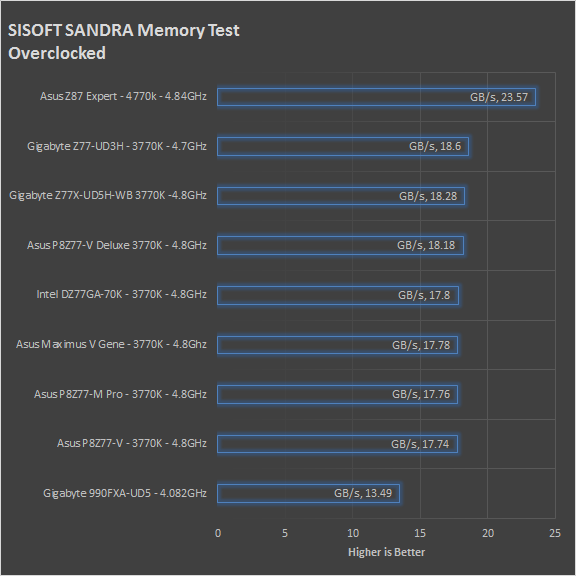
Drive performance -
Drive performance is also one of the major subsystems that goes to make up the performance of a motherboard. For our testing we use Sandra and AIDA64 again. We only test with single drives for each type of controller present on the motherboard (unless it is a professional product where we will use RIAD 5 and/or 10). We have also begun using a Thermaltake USB 3.0 dock with another Kingston HyperX SH100S3B/120G 120GB SSD and a Kingston HyperX USB 3.0 Flash drive for our USB 3.0 performance. As a side note, we include the overclocked numbers here to make sure (again) that you are not going to see a major drop in performance due to minor instabilities at high clock speeds.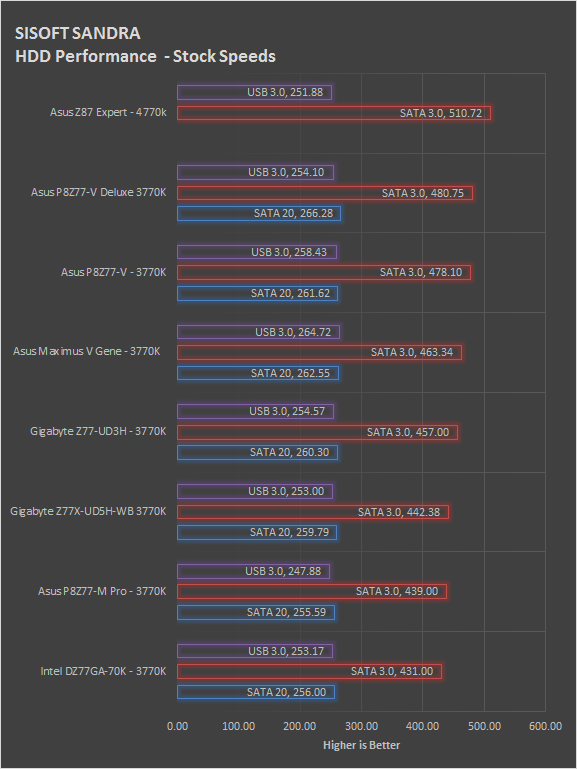
For HDD/SSD performance things have improved quite a bit. SATA 3.0 has improved from the first generations that we saw. The access times have gone up quite a bit as you can see here. Once again we do see overclocking slow down the SATA performance despite the faster CPU and memory speeds.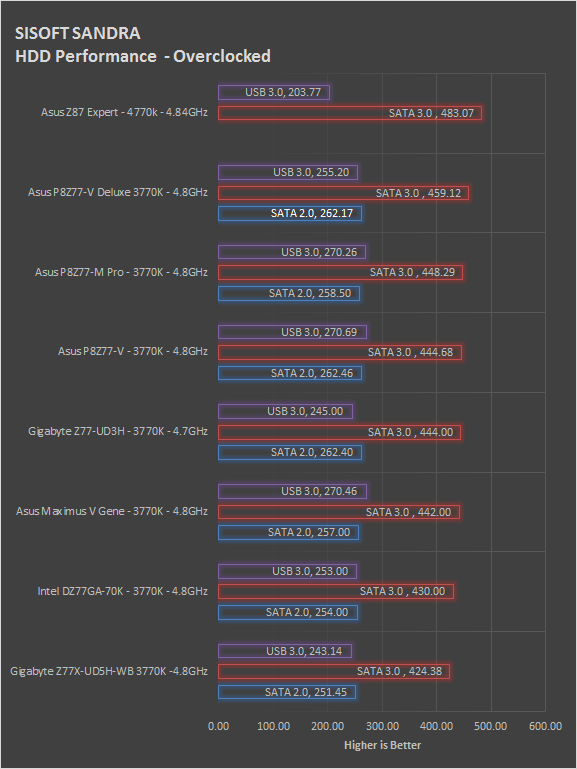
Power -
Power efficiency is another of those misnomers that we get caught up in. We hear about idle states and power gates. But what does that mean to you and I? On the surface having power management that reduces idle power sounds great and can be a benefit to someone that leaves their system on for long periods of time (and inactive) but how a system handles power under load and the delta between the two states is often more important than the idle power usage numbers. We use only P3 Kill A Watt instruments for measuring power. 
The bane of any high-performance system is power. The faster you want to go the more power you draw from the wall. This is true with almost any device you find out there. In the “PC” world it is very evident. Both Intel and AMD have been working to bring that power draw down. They have been cooperating with motherboard manufacturers to pull this off. With Haswell and the Z87 we are seeing some of this come into play, but things are not there yet. The Intel Core i7 4770K combo just gives us acceptable power draw based on what is in the system, but it should be much better.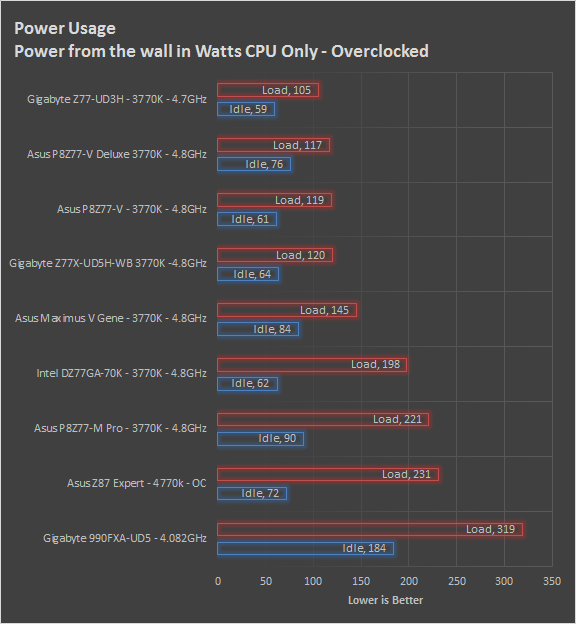
Cooling (Board Level) -
Board level cooling is an important factor in product performance and longevity. Components like the chipset, VRM modules and even capacitors need to be kept relatively cool to prevent failure. As these parts are made of silicon, they have a thermal breakdown threshold; or melting point. At that temperature the actual transistors built into chip will begin to deform and break down. Granted, the threshold is often very high, but you still need to make sure that components stay away from this level of heat for longer product life. 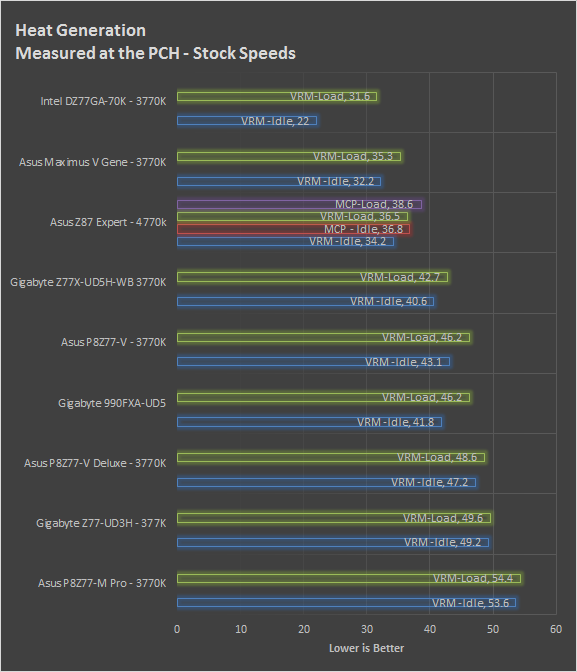
With extra power comes extra heat. Fortunately most motherboard makers have been working very hard to help counter the effects of the extra heat. Over the years Asus has had some very interesting designs indeed. On the Z87-Expert we find that they are, once again, doing a good job. It is just not the best job they could be doing.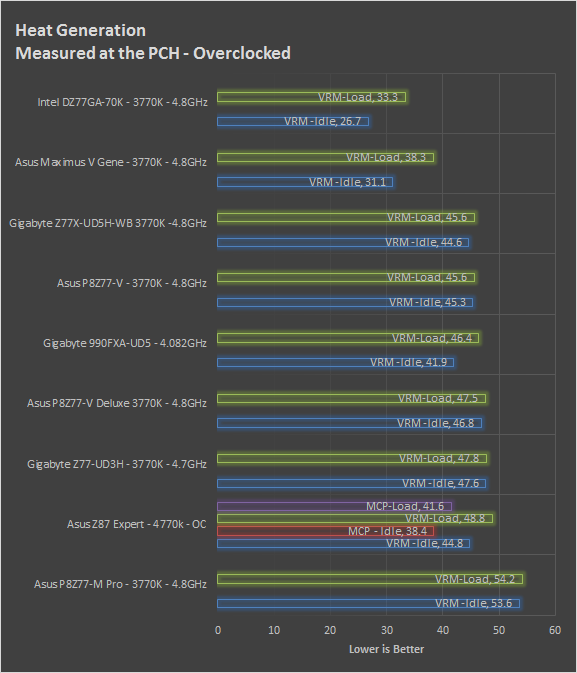
Audio -
Audio is highly subjective. What we find pleasing may sound “off” to you. That is always going to the problem with testing audio; results will vary too widely depending on the tastes of the listener. However, there are ways of measuring the audio output with an objective ear. There is also the issue of audio causing performance issues in gaming and video playback. The reason this is a potential source of concern is that all onboard audio CODECs (Compression/Decompression) are CPU controlled. This means that while the audio chip controls the audio levels and effects of the audio the actual work is done on the CPU. Usually this will not be a problem with today’s powerful CPUs. Even the lower and consumer level products can handle high-end audio these days. But again there is the chance that a bad design or software will hinder your system and performance. On the other side the limits of board space, cost, etc will also prevent the level of audio quality you can get from an add-in board. We test all audio parts with three media types, Movie (DVD), MP3 Music, and Gaming. These are pushed to our Tec On model 55 Tube Amp to see if we can detect any signal issues in the reproduction. The Audio quality on the Z87-Expert is “good enough” it is not going to impress too many people or win any awards. The audio system feels underpowered and a little reedy. If you are simply looking for basic audio this will get you by, but if you want audio for gaming or real multi-media playback you will want to get something else in your system.
Networking -
This one is something that is a requirement anymore. If you have a computer, the chances are good (like 99%) that you are also connected to high-speed internet. With this you need a good and solid LAN chip to make sure that your data flows properly out and back. A long time ago Asus made the decision to move away from using REALTek LAN controllers on most of their motherboards. Instead they opted to use Intel as their standard. This move has improved their networking performance from a LAN side and the results show in a more stable experience. On the WLAN side things are little changed though. Asus has not gone the extra step to bring in an Intel wireless controller so you are going to get about average performance. The antenna that we showed you in part one of this review does a very good job of getting signal and Asus’ WiFi GO package adds extra value to the networking performance of the Z87-Expert.



